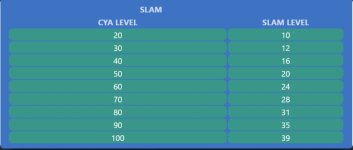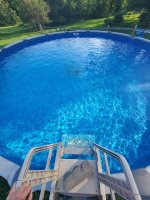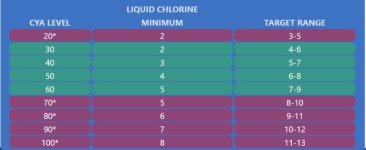TL;DR: (skip down to numbered questions)
This is my first season as a pool owner and my absolute worst fear has just happened - algae.
I have spent all summer trying to get all of my chemicals perfectly balanced at the same time and I FINALLY achieved it about a week and a half ago...and then yesterday I discovered some algae collecting in the middle of the pool. I should have known it was coming bc FC was getting gobbled up more rapidly than usual. I even did regular maintenance level shock treatments* night before last and the night before that. Last night I did a double shock treatment** and I can still see some green in the middle.
I should also note that when I say "some green" I mean the vast majority (95-98% ish) of the pool is crystal clear; we're nowhere near a full bloom (yet).
My plan is to brush and vac to waste after work and then double shock it, see where I'm at tomorrow, and repeat if necessary. In other words, SLAM is the plan. I read the TFP SLAM article (and many others) but I still have some questions.
1. If I brush before vac, which is what it says to do, aren't I going to stir up the algae that's currently collected in the center of the pool, thus causing it to float around instead of resting on the bottom where I can get it with the vac?
2. I also read the OCLT article and it says to wait at least 30 minutes after last chem addition of the day, but how can that possibly give an accurate FC reading? Based on my calculations, it takes roughly three hours for all of the water in my pool to complete a filtration cycle. Testing only 30 min after adding a huge dose of shock doesn't seem like it'd be enough time for it to properly circulate and disperse to yield a reading accurate enough to compare the next morning.
Thanks in advance!
* With the FROG Leap system, a maintenence/normal shock for our pool is 6oz of 100% cal-hypo
** A double shock is what most people without the FROG system would consider a normal shock (1oz/1k gal)
This is my first season as a pool owner and my absolute worst fear has just happened - algae.
I have spent all summer trying to get all of my chemicals perfectly balanced at the same time and I FINALLY achieved it about a week and a half ago...and then yesterday I discovered some algae collecting in the middle of the pool. I should have known it was coming bc FC was getting gobbled up more rapidly than usual. I even did regular maintenance level shock treatments* night before last and the night before that. Last night I did a double shock treatment** and I can still see some green in the middle.
I should also note that when I say "some green" I mean the vast majority (95-98% ish) of the pool is crystal clear; we're nowhere near a full bloom (yet).
My plan is to brush and vac to waste after work and then double shock it, see where I'm at tomorrow, and repeat if necessary. In other words, SLAM is the plan. I read the TFP SLAM article (and many others) but I still have some questions.
1. If I brush before vac, which is what it says to do, aren't I going to stir up the algae that's currently collected in the center of the pool, thus causing it to float around instead of resting on the bottom where I can get it with the vac?
2. I also read the OCLT article and it says to wait at least 30 minutes after last chem addition of the day, but how can that possibly give an accurate FC reading? Based on my calculations, it takes roughly three hours for all of the water in my pool to complete a filtration cycle. Testing only 30 min after adding a huge dose of shock doesn't seem like it'd be enough time for it to properly circulate and disperse to yield a reading accurate enough to compare the next morning.
Thanks in advance!
* With the FROG Leap system, a maintenence/normal shock for our pool is 6oz of 100% cal-hypo
** A double shock is what most people without the FROG system would consider a normal shock (1oz/1k gal)




